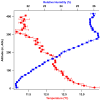Development and Testing of a Rocket-Based Sensor for Atmospheric Sensing Using an Unmanned Aerial System
- PMID: 38544036
- PMCID: PMC10975489
- DOI: 10.3390/s24061768
Development and Testing of a Rocket-Based Sensor for Atmospheric Sensing Using an Unmanned Aerial System
Abstract
Measurements of the vertical structure of the lower atmosphere are important to the understanding of air quality. Unmanned Aerial Systems (UASs, drones) can provide low cost, repeatable measurements of the temperature, pressure, and relative humidity. A set of inexpensive sensors controlled with an Arduino microprocessor board were tested on a UAS against a meteorology grade sensor. Two modes of operation for sampling were tested: a forward moving sampler and a vertical ascent sampler. A small particle sensor (Sensiron SPS30) was integrated and was capable of retrieving vertical aerosol distributions during an inversion event. The thermocouple-based temperature probe and the relative humidity measurement on the Bosch BME280 sensor correlated well with the meteorological sensor. The temperature and relative humidity sensors were then deployed on a rocket sounding platform. The rocket sounding system performed well up to a height of 400 m. The inexpensive sensors were found to perform adequately for low-cost development and uses in education and research.
Keywords: UAS; atmospheric chemistry; atmospheric measurements; drone; rocketsonde; sonde measurements.
Conflict of interest statement
The author declares no conflicts of interest.
Figures













Similar articles
-
A lightweight low-cost and multipollutant sensor package for aerial observations of air pollutants in atmospheric boundary layer.Sci Total Environ. 2021 Apr 10;764:142828. doi: 10.1016/j.scitotenv.2020.142828. Epub 2020 Oct 7. Sci Total Environ. 2021. PMID: 33092832
-
An optimized multicopter UAV sounding technique (MUST) for probing comprehensive atmospheric variables.Chemosphere. 2020 Sep;254:126867. doi: 10.1016/j.chemosphere.2020.126867. Epub 2020 Apr 28. Chemosphere. 2020. PMID: 32957282
-
Moving towards a Network of Autonomous UAS Atmospheric Profiling Stations for Observations in the Earth's Lower Atmosphere: The 3D Mesonet Concept.Sensors (Basel). 2019 Jun 17;19(12):2720. doi: 10.3390/s19122720. Sensors (Basel). 2019. PMID: 31213000 Free PMC article. Review.
-
Development and Calibration of Pressure-Temperature-Humidity (PTH) Probes for Distributed Atmospheric Monitoring Using Unmanned Aircraft Systems.Sensors (Basel). 2022 Apr 24;22(9):3261. doi: 10.3390/s22093261. Sensors (Basel). 2022. PMID: 35590950 Free PMC article.
-
Defending Airports from UAS: A Survey on Cyber-Attacks and Counter-Drone Sensing Technologies.Sensors (Basel). 2020 Jun 22;20(12):3537. doi: 10.3390/s20123537. Sensors (Basel). 2020. PMID: 32580402 Free PMC article. Review.
Cited by
-
Review of Recent Progress on Silicone Rubber Composites for Multifunctional Sensor Systems.Polymers (Basel). 2024 Jun 28;16(13):1841. doi: 10.3390/polym16131841. Polymers (Basel). 2024. PMID: 39000697 Free PMC article. Review.
References
-
- Villalobos-Pietrini R., Hernández-Mena L., Amador-Muñoz O., Munive-Colín Z., Bravo-Cabrera J.L., Gómez-Arroyo S., Frías-Villegas A., Waliszewski S., Ramírez-Pulido J., Ortiz-Muñiz R. Biodirected mutagenic chemical assay of {PM10} extractable organic matter in Southwest Mexico City. Mutat. Res. Toxicol. Environ. Mutagen. 2007;634:192–204. doi: 10.1016/j.mrgentox.2007.07.004. - DOI - PubMed
-
- Lareau N.P., Crosman E., Whiteman C.D., Horel J.D., Hoch S.W., Brown W.O.J., Horst T.W. The Persistent Cold-Air Pool Study. Bull. Am. Meteorol. Soc. 2013;94:51–63. doi: 10.1175/BAMS-D-11-00255.1. - DOI
-
- Finlayson-Pitts B.J., Pitts J.N. Chapter 2—The Atmospheric System. In: Finlayson-Pitts B.J., Pitts J.N., editors. Chemistry of the Upper and Lower Atmosphere. Academic Press; San Diego, CA, USA: 2000. pp. 15–42. - DOI
-
- Mahrt L. Boundary Layer. In: Holton J.R., editor. Encyclopedia of Atmospheric Sciences. Academic Press; Oxford, UK: 2003. pp. 298–305. - DOI
LinkOut - more resources
Full Text Sources

